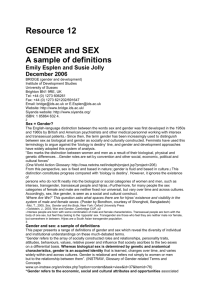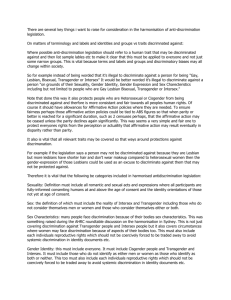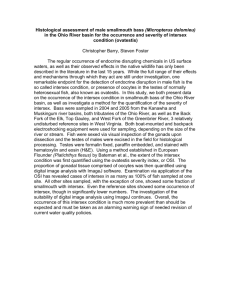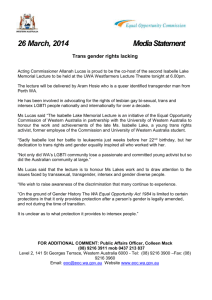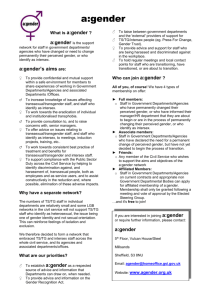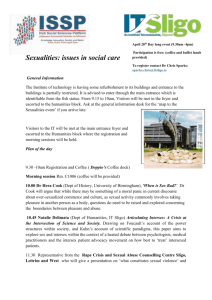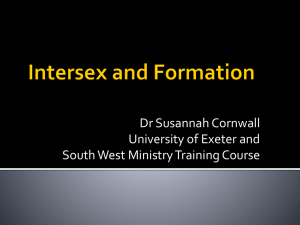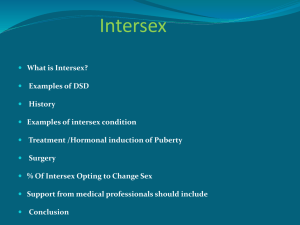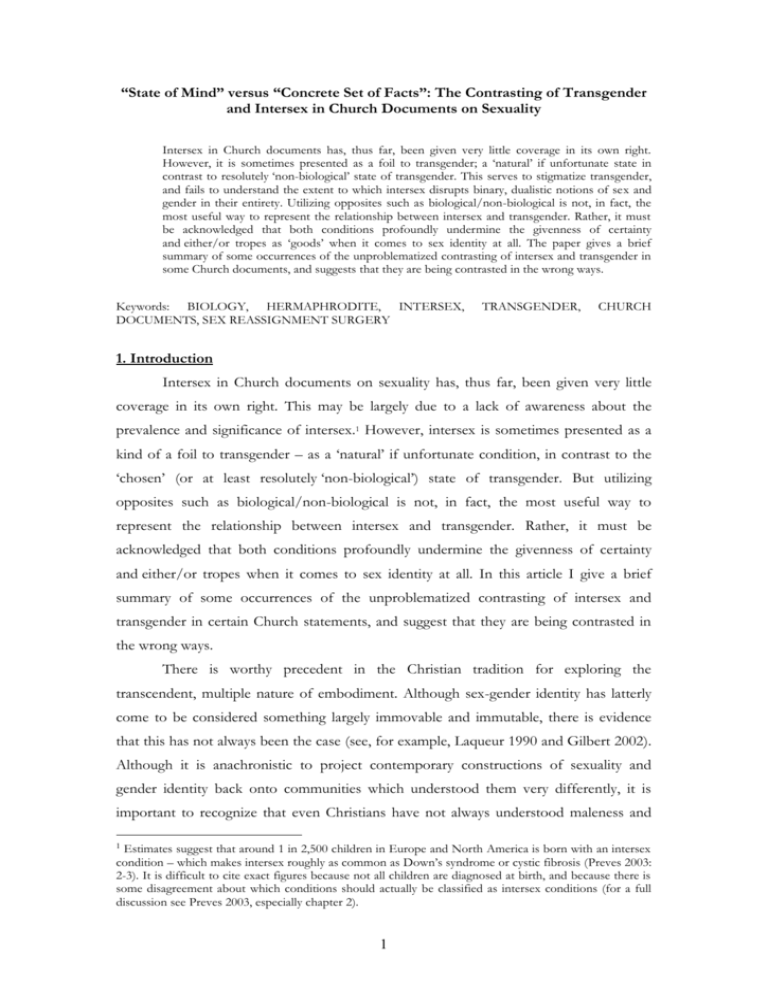
“State of Mind” versus “Concrete Set of Facts”: The Contrasting of Transgender
and Intersex in Church Documents on Sexuality
Intersex in Church documents has, thus far, been given very little coverage in its own right.
However, it is sometimes presented as a foil to transgender; a ‘natural’ if unfortunate state in
contrast to resolutely ‘non-biological’ state of transgender. This serves to stigmatize transgender,
and fails to understand the extent to which intersex disrupts binary, dualistic notions of sex and
gender in their entirety. Utilizing opposites such as biological/non-biological is not, in fact, the
most useful way to represent the relationship between intersex and transgender. Rather, it must
be acknowledged that both conditions profoundly undermine the givenness of certainty
and either/or tropes as ‘goods’ when it comes to sex identity at all. The paper gives a brief
summary of some occurrences of the unproblematized contrasting of intersex and transgender in
some Church documents, and suggests that they are being contrasted in the wrong ways.
Keywords: BIOLOGY, HERMAPHRODITE, INTERSEX,
DOCUMENTS, SEX REASSIGNMENT SURGERY
TRANSGENDER,
CHURCH
1. Introduction
Intersex in Church documents on sexuality has, thus far, been given very little
coverage in its own right. This may be largely due to a lack of awareness about the
prevalence and significance of intersex.1 However, intersex is sometimes presented as a
kind of a foil to transgender – as a ‘natural’ if unfortunate condition, in contrast to the
‘chosen’ (or at least resolutely ‘non-biological’) state of transgender. But utilizing
opposites such as biological/non-biological is not, in fact, the most useful way to
represent the relationship between intersex and transgender. Rather, it must be
acknowledged that both conditions profoundly undermine the givenness of certainty
and either/or tropes when it comes to sex identity at all. In this article I give a brief
summary of some occurrences of the unproblematized contrasting of intersex and
transgender in certain Church statements, and suggest that they are being contrasted in
the wrong ways.
There is worthy precedent in the Christian tradition for exploring the
transcendent, multiple nature of embodiment. Although sex-gender identity has latterly
come to be considered something largely immovable and immutable, there is evidence
that this has not always been the case (see, for example, Laqueur 1990 and Gilbert 2002).
Although it is anachronistic to project contemporary constructions of sexuality and
gender identity back onto communities which understood them very differently, it is
important to recognize that even Christians have not always understood maleness and
Estimates suggest that around 1 in 2,500 children in Europe and North America is born with an intersex
condition – which makes intersex roughly as common as Down’s syndrome or cystic fibrosis (Preves 2003:
2-3). It is difficult to cite exact figures because not all children are diagnosed at birth, and because there is
some disagreement about which conditions should actually be classified as intersex conditions (for a full
discussion see Preves 2003, especially chapter 2).
1
1
femaleness, masculinity and femininity as either-or, mutually-exclusive categories in
exactly the ways that we might suppose. Caroline Walker Bynum, Sarah Coakley, Michael
Nausner and others have usefully reflected on unusual or even overtly ‘gender-bending’
figurings of gender in the medieval mystics, in Gregory of Nyssa and elsewhere (see, for
example, Bynum 1986; Coakley 2002: 127-9; Nausner 2002). What this means is that
‘queer’, transgressive and ‘crossing’ bodies are always already present to theology in its
own past, and that ‘atypical’ intersexed or transsexual bodies therefore already map onto
the mixed-up, much-inscribed Body of Christ. These bodies’ distinct, specific existences
can speak to what all bodies mean in relation to one another, despite and because of their
unusual or statistically rare (and therefore particular) statuses.
As well as these hints in its own tradition, Christianity must take proper account
of work going on in other disciplines which disrupts and problematizes a
heteronormative and biologically-essentialist matrix for human sex-gender identity.
Georgia Warnke, for example, has convincingly shown that to call certain characteristics
monolithically ‘sexed’ as either male or female is as problematic as calling certain other
characteristics ‘raced’ (Warnke 2001).2 Although we might have come to associate the
term ‘sex’ with biology and the term ‘gender’ with culture, the particular characteristics
we choose to imbue with sexed meaning have shifted over time and are likely to shift
again: Thomas Laqueur argues that it has been changes in cultural assumptions about the
significance of masculinity and femininity which have led to shifts in figuring maleness
and femaleness, not the other way around (Laqueur 1990).
Despite all this, however, Christianity’s recent concern with discrete and stable
sex-gender identities has meant that Church statements on sexuality since the 1990s have
almost universally understood shifts or ambiguities in sex-gender as pathological or at
least less than ideal. The apparently unproblematized linking of transsexualism with
psychological disturbance and sin is evident in documents such as Issues in Human
Sexuality, the 1991 statement by the Church of England’s House of Bishops.
Warnke argues, ‘The concept of race does not hold up as a scientifically viable way of grouping human
beings. It does not identify a cluster of genes at the biological level that could serve to sever human beings
into neatly separable groups. It does not help identify discrete packages of color and morphology that
could separate groups. It is muddled and asymmetrical in its groupings of individuals by ancestry. Finally,
while genetic predispositions to certain diseases might provide a more useful way of grouping individuals,
at least for medical purposes, such groupings deviate from ordinary uses of the term “race” …[Intersex]
surgery raises the question of what our categories of sex are meant to refer to: chromosomes or anatomy?
Moreover, if they can refer to either depending on the decisions of teams of doctors, how different, really,
are the categories of sex and race? Is assigning a female sex to an infant with one Y chromosome any more
securely based in “nature” than assigning a black race to a pinkish infant with one-sixteenth AfricanAmerican heritage?’ (Warnke 2001: 126, 128).
2
2
2. Church of England: Issues in Human Sexuality
Issues in Human Sexuality is extremely heteronormative throughout, presenting the
monogamous, heterosexual married couple as the unproblematized ideal (Church of
England 1991: 9). In this light, it may be considered unsurprising that anyone who elects
to ‘compromise’ their capacity to marry and to bear children should be thought of as
perverse. As might have been predicted, transsexualism itself is addressed in Issues
entirely in one short paragraph which also deals with the ‘problems’ of sex addiction and
those who find genital sex difficult or impossible (such conflation being revealing in
itself, with its implication that transsexualism bears reflection only as a discomfiting
curiosity). The statement reinforces throughout its early assertion that ‘sin can disturb the
delicate balance of the man-woman partnership’ (Church of England 1991: 7). As such,
transsexualism can only be understood as arising from and being symptomatic of this sin:
Human sexuality is a very fragile system, easily distorted and broken. There have always been a
certain number of both men and women … whose sexuality feels to them at odds with their
bodies, so that they become convinced of their need for sex change, or enter the world of the
transvestite. Damage to sexuality, sometimes irreversible, can be done very early in life. The
personality is given a twist which puts normal sex out of reach. (Church of England 1991: 26-7)
The whole, brief discussion of transgender is sandwiched between the languages of
damage and perversion. But the paragraph’s treatment of the topic falls short for other
reasons than this. Appealing to a ‘sexuality’ which ‘feels … at odds with their bodies’ is a
strange phrasing, and telling in its strangeness. Surely it is their gender that transgendered
people find to be at odds with their bodies, and not specifically their sexuality? A male
who found himself exclusively attracted to men would be unlikely to assume as a first
step that he was in the ‘wrong’ body; rather, the majority of such men would identify as
homosexual. This, however, is where the statement’s overweening heteronormativity is
so limiting: since Issues cannot conceive of homosexuality as a fully legitimate identity, it
cannot think it into the minds of those whose experiences it purports to present either.
Undoubtedly, the ‘normal sex’ which is put out of reach here is the kind of sex which
happens between a male man and a female woman, ideally within a marriage.
But why is this attitude which considers heterosexual, penetrative sexual
intercourse the norm, and any variation from it deviant or inadequate, quite so strong?
This becomes evident later in the document: the a priori given to which other factors
must be subsumed is gender complementarity:
3
It is important for the mature development both of individual men and women and of society
that each person should come to understand and to value … complementarity … The fact that
heterosexual unions in the context of marriage and the family are of such importance for the
fostering of true man-woman complementarity seems to us to confirm their essential place in
God’s given order. (Church of England 1991: 37-8)
This obsession with complementarity means that human identity is caricatured,
‘immature’ development (which presumably means any non-standard understanding of
sexuality and gender) stigmatized, and difference pinned solely on sex rather than on any
of the other elements contributing to the tension of sameness and difference within
which human interaction takes place:
In heterosexual love... personal bonding and mutual self-giving happen between two people who,
because they are of different gender, are not merely physically differentiated but also diverse in their
emotional, mental and spiritual lives. (Church of England 1991: 37) (my emphasis)
In fact, this is a grossly inadequate representation of otherness. Whilst gender is
important as a repository for identity through which difference and diversity are
expressed, it is not the most fundamental thing about being human, nor the only thing in
which difference inheres.
Intersex is not acknowledged in Issues at all, and so cannot be contrasted with
transgender, adequately or otherwise. However, it is important to note the worldview and
attitude to transgender – and to sexuality more broadly – assumed in Issues since these
underlie the fuller 2003 document Some Issues in Human Sexuality. What we can take from
this brief look at Issues is its profoundly heteronormative bent, and its deep investment in
gender complementarity as providing the correct basis for human sexual relationships.
This is particularly important because it hints at the kinds of background work most
valued by the compilers of Issues and Some Issues.
3. Church of England: Some Issues in Human Sexuality (I): Holder
Some Issues contains a whole chapter focusing on transsexualism, and briefly
acknowledges intersex too. Given the norms and ideals reflected in Issues it is
unsurprising that the chapter in Some Issues draws so heavily on work by Rodney Holder,
who also extols complementarity as virtue and ideal. In his two short essays, Holder is
keen to distinguish transsexualism from what he calls ‘other conditions of ambivalent
4
sexuality’ (Holder 1998a: 90), in which he includes intersex. It seems evident that this has
influenced the writers of Some Issues. Of course, scholars and activists working in intersex
in the last two decades have often been keen themselves to stress that intersex and
transgender are different phenomena, and that for transgendered people to annex
intersex support groups claiming that they are intersexed is inappropriate. For example,
the webpage of the Androgen Insensitivity Society Support Group insists,
Intersex is not the same as a transsexual (gender dysphoria) or as a transgender state. Neither term is
one that we recognise as belonging in any general discussion of intersex. We are not happy with
the recent tendency of some trans groups/people to promote transgender as an umbrella term to
encompass, for example, transsexuality, transvestitism and intersex … This trend towards
“muscling in” on intersex issues seems to be a initiative on the part of certain politically-minded
people in the “trans” community, to bring intersex under their banner … or even to actively
interfere in clinical issues relating to intersex. (http://www.aissg.org/21_overview.htm)
Part of the reluctance of AISSG and other intersexed people (see, for example, Koyama
2006) to be considered in the same breath as non-intersexed transpeople is because of
the association of transgender with gender identity problems, which many intersexed
people never face. Where one’s agency and selfhood are already likely to have been
eroded by others (particularly medical professionals) seeking to impose unsolicited and
even harmful ‘expertise’, the desire to maintain a distinction between intersex and
transgender is justifiable and understandable. What, then, is wrong with Holder’s
particular contrasting of the two conditions and the way it is taken up in Some Issues?
Holder’s division between intersex and transgender is based not in questions of
biography but in questions of biology. Holder asserts that transsexualism stands ‘in
contrast to hermaphroditism [i.e. intersex], which is a congenital disorder in which both
male and female gonads are present and the external genitalia are not clearly male or
female’ (Holder 1998a: 90). We see clearly here how intersex – in Holder’s terms,
‘hermaphroditism’, since he is somewhat confused in his vocabulary3 – is presented as a
foil to transgender. Holder says that surgery for transgendered people is ‘in principle no
different from that in the case of hermaphroditism’ (Holder 1998b: 129); his reasons for
Although Holder uses the term ‘hermaphroditism’ rather than ‘intersex’, it is clear that he is referring to a
range of intersex conditions, and not solely those involving ovotestes. Although it is now considered
archaic, hermaphroditism used to be commonly used as an umbrella term for intersex conditions. Holder is
wrong to characterize hermaphroditism solely as the possession of male and female gonads and ambiguous
genitalia. In fact, only those who were in the past called ‘true hermaphrodites’ have both ovarian and
testicular tissue; most intersexed people do not have both male and female gonads. Nor is it always true
that the external genitalia are ambiguous, which is why some intersex conditions are not discovered in
childhood.
3
5
this assertion are grounded in the arguments of Oliver O’Donovan, which I examine
below. Holder munificently acknowledges that although surgery cannot change the
transsexual’s ‘prima facie birth sex’ (that is, the biological sex according to current
conventions of what this comprises) any more than it can that of the ‘hermaphrodite’,
social interaction and gender identity must be taken into account in both cases (Holder
1998b: 130). Holder himself therefore recognizes that some of the shared issues and
overlaps between the conditions may mean intersex deserves more than a cursory
engagement from theologians.
Significantly, however, although Holder himself is careful to entertain both
biological and non-biological origins for transgender, and to outline carefully some of the
moral implications for considering transgender a ‘psychological’ rather than a ‘physical’
condition (Holder 1998a: 92-4), Some Issues does not manage to be quite so open-minded.
Some Issues uses Holder’s assertion about hermaphroditism specifically to demonstrate by
contrast the unambiguous nature of transgendered people’s ‘biological sex’ (Church of
England 2003: 223). There is no doubt, we are told, about their sex – since sex is
assumed to be unproblematically physical and therefore ‘readable’ from physical
characteristics, unless access to them has somehow been frustrated. However, as we see
in Warnke and Laqueur (and as I discuss more fully later), such is not necessarily the
case. Contrasting transgender and intersex solely on the grounds of whether or not
particular biological pointers to sex are or are not evident therefore seems somewhat
naïve.
The way in which Holder’s work is used in Some Issues is largely to accept and
recapitulate
a
series
of
unproblematized
binaries:
ambiguous/unambiguous,
equivocal/unequivocal, and so on. For Some Issues, intersex unproblematically links with
the former term and transgender with the latter – despite the fact that atypical genitalia
need be figured as ‘ambiguous’ only if it is assumed that there is a real, solely-binary truth
which they are failing to ‘tell’. In fact, accepting that categories of human sex work largely
by convention, and that there may be huge variations within sexes as well as between
them, means that holding intersex as somehow more ‘real’ or ‘legitimate’ than
transgender (because intersex is a unique instance of indistinctness) is misguided. For Some
Issues, the equivocal/unequivocal binary seems to be maintained largely because it
reinforces the notion that sex-gender identity is not a human choice, but simply a
foregone conclusion stemming from what the bishops term ‘God-givenness’. ‘Godgivenness’ seems suspiciously heteronormative, since ‘healthy’ manifestations of gender
6
are presented only as those which supervene on (unproblematized) biological sex, and
promote gender-based complementarity. More engagement with scholarly work
assuming a model of human sex and gender which is, at least in part, socially constructed,
would have allowed for both a non-pathological understanding of transgender on the
part of the bishops, and a recognition that contemporary understandings of biology are
neither divinely-ordained nor set in stone.
4. Evangelical Alliance: Transsexuality
There are other problematic assumptions underlying Some Issues, too. It also
draws heavily on Transsexuality, a 2000 report by the Evangelical Alliance Policy
Commission which has become influential in its own right within evangelical churches.
This document is particularly invested in presenting intersex as ‘natural’ (that is, based in
genuine biological ‘ambiguity’) and transgender as ‘chosen’ (because the biology is
understood as unproblematically pointing to a certain narrow conclusion), as we shall
see. This seems to be done in order to bolster a heteronormative agenda and present
non-heterosexual sexualities as illegitimate. Its handling of intersex is also telling, and the
document is worth examining in some detail.
Transsexuality lists both ‘hermaphrodite’ and ‘intersex’ in its glossary. Although it
is positive that distinctions between hermaphroditism and intersex have been drawn,
since the two are still so often conflated, it is a shame that this was not done more
accurately. These are the definitions of ‘hermaphrodite’ and ‘intersex’ as given by the
Evangelical Alliance document:
Intersex: Refers to a number of rare medical conditions where people are born with ambiguous
sexual characteristics, and nearly always due to physiological causes. Commonly, this may be
shown by the presence of intermediate forms of external genitalia. Congenital adrenal hyperplasia, in
which a girl is born with a masculinised clitoris, and chromosomal abnormalities such as Turner’s
syndrome, are among the medical conditions known as “intersex”. When an intersex condition is
present there is usually a clear physiological causal condition … Despite frequent arguments to
the contrary, transsexuality should not be regarded as a genuine recognised “intersex” condition.
Most biological investigations of transsexuals have found no abnormalities in chromosomal
pattern, in the gonads (which include the internal and external sexual organs), or in sex hormone
levels that could account for the condition. (Evangelical Alliance 2000: 3-4).
Hermaphrodite: One of a number of rare clear physiological causal medical congenital conditions
where the sex of newly born babies is ambiguous due to the presence of gonads and genitalia of
both sexes, such people being termed “hermaphrodites”. An individual with testicular feminisation
7
syndrome, for example, appears normal at birth, but actually has testes as well as a clitoris. The
condition is usually treated in early childhood by surgery and hormone therapy. (Evangelical
Alliance 2000: 3).
I cite these definitions at length in order to show up the muddled and misleading
thinking contained within them. Like Holder, the authors of this document have made
the mistake of believing that ‘hermaphrodites’ have both gonads and genitalia associated
with males and females. In fact, ‘true hermaphrodites’ (those with ovotestes, the only
individuals to whom the unfortunate and outdated term ‘hermaphrodite’ may be applied
with any degree of accuracy whatsoever) only very rarely have ambiguous genitalia.
‘Testicular feminization syndrome’ (an archaic term for the condition now known as
Androgen Insensitivity Syndrome) is an example of intersex, but not of hermaphroditism
as the EA suggests. Turner’s syndrome is a highly debated condition and is often not
included under the umbrella of intersex, which makes it odd that the EA has chosen to
highlight it particularly. Finally, referring to an individual with Congenital Adrenal
Hyperplasia as having a ‘masculinised clitoris’ (as opposed to one which is simply larger
and more prominently hooded than average) is extremely controversial and betrays a
dualistic, essentialist picture of sex, which stigmatizes difference.
That the entry on intersex makes clear its ‘physiological causes’ is obviously
deemed so important that it is repeated only two sentences later. It soon becomes clear
why: this is the primary way in which intersex is contrasted with transsexuality, for which
‘most biological investigations’ have found no explanation. The entry for transsexualism
stresses repeatedly that transsexual people are ‘biologically normal’; that there is ‘no
doubt’ about their ‘actual biological sex’ (EA 2000: 5). Indeed, Some Issues takes this up
straight away, repeating and reiterating that, ‘in the case of transsexuals, there is no doubt
about their biological sex’ (Church of England 2003: 223). The implication is clear: since
transsexualism is not biological, it can only be a psychological condition, and since
‘healthy’ psyches are heterosexual psyches, transgender must be a problem, a result of
living in a sinful world. Likened to alcoholism (EA 2000: 20) and other forms of
addiction (EA 2000: 26), it can therefore only be pathological. ‘[Transsexualism] is largely
concerned with a state of mind … rather than any concrete set of facts’ (EA 2000: 38),
claims the EA. This total dismissal of psychological states as having any kind of actuality
is bizarre, and apotheosizes biological ‘truths’ to an extent which seems entirely unaware
of any anti-essentialist criticism whatsoever.
8
The sense in the EA document that conditions which are ‘merely’ psychological
can be eradicated through therapy – even if some transgendered people may reject this
(EA 2000: 23) – is a dangerous one. If swallowed, it implies they can be explained away
and ‘disappeared’, rather than dealt with head-on as real and permanent aspects of
identity. That one’s ‘state of mind’ cannot, in this account, be considered part of a
‘concrete set of facts’ about one’s integrated body-self is profoundly dualistic, and
heightens the problematic distinction being drawn between ‘real’ and ‘false’ evidence
about sex-gender identity. This is unfortunate, particularly since the writers of the EA
document seem motivated by a genuine desire to ensure that people with gender
dysphoria can access therapy for any underlying issues such as poor self-esteem, parental
rejection and peer pressure, rather than being fobbed off by doctors who may see sex
reassignment surgery as an easy fix (EA 2000: 26). But although counselling and
extensive discussion are, of course, crucial precursors to sex reassignment surgery, the a
priori assumption in this document (and in Issues) that gender dysphoria always means that
the mind must be changed and not the body will colour the manner in which
transgendered people are considered. Just because transgendered people cannot help
being that way, states Some Issues, ‘this does not necessarily mean … that a transsexual
person cannot come to accept his or her biological sex’ (Church of England 2003: 227).
Biology is still the immutable a priori which must be ‘accepted’; not ‘accepting’ biology
signals the beginnings of ‘a gnostic dualism in which the body is seen as separate from
the self’ (Church of England 2003: 249). But holding as pre-existent ‘known fact’ that all
transgendered people are mentally ill or delusional profoundly undermines their
legitimacy as authors and actors of their own identities, and fails to disturb the genitalcentric model of human sex which often seems to win through in the Church statements
despite their acknowledgement of other models.
The declaration in the EA document and in Some Issues that there is ‘no doubt’
about the biological sex of transgendered people is troubling for a still deeper and more
profound reason. Such an assertion assumes that human sex is generally something
which can be known without any doubt – that it is somehow beyond doubt, except in the
case of ‘abnormal’ people. This is extremely problematic once we have recognized the
provisional and arbitrary nature of all human sex assignment. Nobody can know for sure
that the child born with testes and an acceptably-sized penis and who is assigned ‘boy’
accordingly will continue to identify as a boy and man as he grows up. Just because
individuals usually stick to the assignments bestowed at birth, which have been reinforced
9
throughout infancy and childhood, does not make the assignments any less provisional.
The fact is that, on our current understandings of sex, we happen to prize certain
characteristics – namely, the appearance of the external genitalia of children at birth –
above others. Unless there is any ‘ambiguity’ about these features, further investigation as
to karyotype (that is, chromosomal configuration) or gonads is unlikely to occur until
much later, if at all. (In cases of Androgen Insensitivity Syndrome, where children have
male-related gonads and XY chromosomes, but also have female-related genitalia, the
condition may not be identified at all until puberty when a girl does not begin to
menstruate as expected.) As Warnke, Laqueur, Dreger, Gilbert and others have shown,
sex has not always been assigned in exactly the same way as it is now. It is therefore
conceivable that it will not be assigned this way forevermore, and that the particular
‘biological’ distinction which the Church documents tend to draw between intersex and
transgender will no longer stand, because different biological or non-biological
characteristics will have come into vogue as more significant signposts of sex.
So the authors of Some Issues are, it might be said, just a little naïve in their
insistence that ‘physiological and psychological factors are not susceptible to change in
the same way as social factors’ (Church of England 2003: 226). Given that classification
as intersexed, for instance, can depend on a difference of a few millimetres’ glans size,
Morgan Holmes claims, ‘In a sense, “intersexuality” is nothing more than a perpetually
shifting phantasm in the collective psyche of medicine and culture’ (Holmes 2002: 175).4
Moreover, as Preves and Kessler have noted, even the medical guidelines on what
constitutes a too-large clitoris or a too-small penis at birth are not universal or
unchanging (Preves 2003: 55; Kessler 1998: 38-40, 99-100). Thomas Laqueur, in Making
Sex, provides a particularly well-known and thorough exploration of the ways in which
the ways in which sex difference has been figured at given times in history, arguing that
this has been ‘largely unconstrained by what was actually known about this or that bit of
anatomy, this or that physiological process’, and ‘derive[s] instead from the rhetorical
exigencies of the moment’ (Laqueur 1990: 243). He says,
The history of the representation of the anatomical differences between man and woman is…
extraordinarily independent of the actual structures of these organs or of what was known about
Of course, says Holmes, conditions such as salt-wasting Congenital Adrenal Hyperplasia are genuinely
pressing medical concerns and should be addressed; however, the health risks attached to some conditions
which cause ambiguous genitalia are not identical to the concerns about the unusual-looking genitals
themselves, and the two should not be conflated (Holmes 2002: 175).
4
10
them. Ideology, not accuracy of observation, determined how they were seen and which
differences would matter. (Laqueur 1990: 88)
This goes for the ‘atypical’ genitalia associated with intersex as much as with ‘typical’
male-related and female-related genitals.
The unquestioned privileging of genital-appearance-at-birth over other matrices
of sex-gender identity can be clearly seen elsewhere in the EA report. It is the reason
why ‘sex-ambiguity’, on this account, can only be an intersex-linked occurrence and not a
trans-linked one:
We need to start by distinguishing between sex-ambiguity as a physiological fact at birth (the
phenomenon of the “intersex” or “hermaphrodite” state constituting examples of such
ambiguity), and transsexual phenomena. Something which is ambiguous between two distinct
things, and where ambiguity is regarded as bad, will need to be resolved if possible into one or
other of these distinct possibilities; this process of resolution usually takes place in the rare
individual cases of sex-ambiguity without “transsexual” issues ever arising. (Evangelical Alliance
2000: 58)
But what the report does not acknowledge is that intersex does not only exist as an
example of something which stands between two distinct things; actually, it
problematizes the model of their being two distinct things in the first place. Intersex
shows that human sex is not a simple binary; and, since any exception to a dualistic model
necessarily undermines the model in its entirety, this makes essentialist assumptions
about what constitutes ‘concrete facts’ even more precarious.
The EA report, however, will not acknowledge this, insisting instead,
Sex is fundamental to being human; each person is, inevitably, male or female. Sometimes the
process of sexual typology is not straightforward, as the “intersex” case has shown. But that
merely confirms sexual typology to be a matter of interpretation of a reality distinct from the
judgement made. (EA 2000: 63)
This, however, is a circular argument. It presupposes that the attempts to make
intersexed bodies fit into a ‘typology’ at all are correct, and fails to ask whether the socalled ‘reality distinct from the judgement’ has itself neglected to take account of the
‘exceptions’, which may well turn out to be, after all, not so exceptional. There is no
sense that the binary model of masculine maleness and feminine femaleness might be a
provisional or inadequately narrow one. Indeed, and almost unbelievably, the report
11
admits that even if it could one day be demonstrated that transsexualism were a kind of
late-onset intersex, ‘the case for the essential givenness of sex, as argued in this report,
would remain largely unchanged’ (EA 2000: 67).5 There seems to be an implication that
any discovery of a ‘physical causation’ of transgender might necessitate ‘potential
corrective physical or genetic treatment’ (EA 2000: 23). Ironically, given the repeated
assertion that transsexualism is to be contrasted with the genuine biological state of
intersex, it is very clear here that any new evidence about a biological basis for
transsexualism is to be subsumed to the existing biblical witness – as it is interpreted –
about the nature of human sex and gender (EA 2000: 48). As Adrian Thatcher comments
in response to the use of Scripture in Some Issues,
Genesis 1 and 2 are required to bear an impossible weight of interpretation … To say Genesis
provides a “framework for understanding what it means for us to be male and female before
God” is already to offer interpretation well beyond what the text itself is able to authorize. There
need be no objection to such interpretations, of course, provided that they are understood as the
outcome of the engagement of some readers with the text. But the bishops want far more than
this. They are able to derive “what it means” to be male and female, and just from this text!
(Thatcher 2005: 21-2)
The writers of the EA report are doing something very similar, pinning their responses to
transgender on biblical texts which do not claim to be telling ‘scientific’ truths about
human sex. Theology must absolutely defend its capacity to critique modern science and
culture, but doing so on the basis of a shoddy bibliolatry gets no-one anywhere. 6
The case for the essential givenness of sex, as argued in the report, goes something like this: Genesis 1:27
demonstrates that Adam and Eve were created male and female, which means that ‘our sexual identity is
part of the “givenness” of how we have been made’ (EA 2000: 48). (No sense, then, that the Adam and
Eve story might be read parabolically rather than literally, or that ‘sexual identity’ does not always
supervene on maleness or femaleness.) The verse emphatically ‘does not teach, as some allege, that
maleness and femaleness are two poles between which is a spectrum or ambiguous blend of human
sexuality’ (EA 2000: 48). Those who find their gender identity at odds with their genitals must, then, be
‘fundamentally mistaken given the biblical assertion of the priority of the physical’ (EA 2000: 48-9).
Transsexuality always falls short of ‘God’s revealed ideal for the expression of sexuality’ (EA 2000: 49) –
that is, heterosexual marriage open to the possibility of procreation. Why? Because a marriage involving a
post-transition transgendered person will be ‘a deceptive representation of an apparent heterosexual
relationship’, which is ‘arguably more subtle and devious than an overt homosexual relationship’ (EA 2000:
50). In sum, ‘The notion of a given, created, dimorphic humankind, as expressed in the book of Genesis,
and the sanctity of a complementary relationship between male and female, is fundamental to Christian
thought’ (EA 2000: 73).
6 Genesis 1 is not the only passage to be treated so unreflectively; the report also states, ‘Because [our sex]
is fundamental, it is not an historical phenomenon. It is not subject to development. We do not actually
become male or female. Our male/femaleness “unfolds” in a progression from genotype to phenotype.
Although this is acknowledged to be a controversial assertion, and some experts who are committed to the
development of the concept may well resent rejection of the ‘becoming’ of sexual identity, we nevertheless
make our assertion at least in part on the basis of Psalm 139’ (EA 2000: 63-4).
5
12
The EA report comments, ‘A definitive medical “intersex” condition … cannot
in our view be considered as in any way comparable to the transsexual claim of wanting
to be recognized as really “a man in a woman’s body” or vice versa’ (EA 2000: 66). But
the logic behind this is based solely in the so-called certainty attached to intersex, rather
than because of any reflection on the other social and political differences between
intersex and transgender. A change of sex on a birth certificates might be legitimate for
intersexed people, because there has been a ‘genuine medical mistake’ – not so for
transsexuals, says the EA (EA 2000: 87). There do remain important distinctions
between transgender and intersex, not least surrounding when genital alteration takes
place and on whose terms. However, if the ‘‘transsexual’ issues’ cited above are taken to
mean gender identity issues, it would be misleading to ignore the large body of work
which suggests that people with intersex conditions sometimes do have queries over their
gender of rearing as a direct consequence of attempts to ‘resolve’ their ‘ambiguity’. Even
where something is ‘biological’ this does not necessarily render it easily categorizable.
5. Evangelical Alliance: Gender Recognition: A Guide for Churches
The Evangelical Alliance’s 2006 document, Gender Recognition: A Guide for Churches
to the Gender Recognition Act (UK), is an attempt briefly to update the lengthier 2000 report,
and to explain specifically how the Gender Recognition Act 2004 might impact legally on
churches. It was published as a joint venture with Parakaleo Ministry, a Christian
organization ‘seeking to uphold Biblical values to the transvestite, transsexual and
transgendered person’ (www.parakaleo.co.uk/index.html). According to Parakaleo’s
website, this involves mentoring ‘those seeking to re-establish their God given gender
identity and destiny’ (www.parakaleo.co.uk/index.html). Although the document is
positive in its acceptance of the ‘reality’ of intersex conditions, its desire to distance them
from transsexualism again leads to some demarcations between the two being drawn
where they do not necessarily exist. For instance: ‘Intersex conditions result from a
chromosomal disorder. Transgendered people by definition do not have a chromosomal
disorder and therefore show no evidence of physical sexual ambiguity’ (EA 2006: 5).
Not all intersex conditions do, in fact, arise through chromosomal disorders; it is
not only inaccurate for the report to claim they do, but also bizarre, given that the same
document later cites a survey of medical literature which acknowledges that at least a
portion of intersex conditions have ‘no discernable medical cause’ (EA 2006: 21). The
document seems keen to differentiate intersex and transsexualism, on the logic that
13
something with a biological cause cannot be dismissed in the same way as something
which has ‘only’ a psychological cause or which is a conscious choice, even if can still be
pathologized on other grounds. However, this obsession with the ‘truth’ of biology is
nothing but a new essentialism, and does not adequately question what happens when
essentialist readings of bodies are allowed to become prescriptive imperatives for how all
bodies are to be. Actually, both intersex and transgender as phenomena result from
complex interactions between bodies and societies. The ways bodies are read is affected
as much by what one expects to see as by the bodies themselves. As Sharon L. Crasnow
has commented,
Since [models] provide an intermediary between world and theory, they are neither world nor
theory. However, the theory indicates what sorts of things can count as models of it. The
presupposition that there are two sexes is a theoretical presupposition and the models must be
constructed so as to fulfil that theoretical claim. We might think of models more clearly as tools
with which to think about the world. We need such tools for a variety of reasons, not the least of
which is that the world has too much going on in it and we need to make choices about which
particular features we should be looking at. Just that recognition alone, however, gives a different
slant to what it is that science does. So the theory is describing the model, not the world.
(Crasnow 2001: 143)
6. Church of England: Some Issues in Human Sexuality (II): O’Donovan
The 2006 EA document appeared too late to have directly influenced Some Issues,
but I now come to a discussion of another author whose work is quoted extensively by
the bishops in the latter document: Oliver O’Donovan. O’Donovan’s 1982 Grove
booklet on transgender is still one of the most important and considered theological
responses to the issue nearly three decades later. Like those who followed him,
O’Donovan contrasts intersex with transsexualism, apparently in order to present
transsexualism as less legitimate. O’Donovan implies that, as well as threatening the
broad integrity of the person, sex reassignment surgery transgresses the givenness of the
particular body as it is, so that to redefine the body sculpturally is to take the ‘cult of
autonomy’ to extremes. O’Donovan asserts, ‘To know oneself as body is to know that
there are only certain things that one can do and be, because one’s freedom must be
responsible to a given form, which is the form of one’s own experience in the material
world’ (O’Donovan 1982: 15). He insists that sex reassignment surgery goes beyond the
limits appropriate for human bodies. O’Donovan is anxious to avoid a body-soul duality,
and is suspicious of any surgery not absolutely necessary to the promotion of the
14
integrity of the person. He seems to view transsexual surgery as inherently cosmetic (and
thus superfluous) rather than therapeutic.
Interestingly, however, this response to transgender is not consistently applied.
O’Donovan’s logic is not followed through in his reaction to intersex.7 O’Donovan
seems happy to concede that ‘surgery… is appropriate to resolve the ambiguities of the
hermaphrodite… The resulting sex… is the real sex of the hermaphrodite. That is to say,
it is the sex to which, in view of the ambiguity, it is sensible to assign him’ (O’Donovan
1982: 13). In this instance, ‘real sex’ is accepted as a pragmatic decision-based
phenomenon, even though this was rejected in the case of transsexualism. On the one
hand, O’Donovan argues that humans are either male or female as made so by God, and
cannot choose to change this by subsuming their ‘true’ sex via surgery;8 yet, on the other,
he insists that the true sex of intersexed people is that to which they have been surgically
assigned. O’Donovan wishes to refute the argument that individuals could ever find
themselves ‘trapped in the wrong body’; rather, he holds, the body they have, sex and all,
is an integral part of who they are. However, he legitimates surgery on intersexed bodies
to ‘resolve’ their ‘ambiguities’.
There is an error of reasoning here. J. David Hester comments of O’Donovan’s
argument, ‘Apparently, not having an identifiable sex is an emergency and something
worth correcting, but having the “wrong” sex is not… This looks to be a serious
inconsistency… when what is at stake in both cases is gender assignment’ (Hester 2004:
216). Essentially, O’Donovan is saying that transsexuals can change their sex – that is,
subsume all their beliefs about what their sex really is – but only in one direction. So in
attempting to resist a body-soul dualism he actually reinscribes it, privileging ‘irreducible’
bodily sex over complex gender identity. The risk here is that those who draw on
O’Donovan’s work see the contrasting of ‘biological’ intersex and ‘non-biological’
transgender as a reason to shirk their duty to engage fully with transgender as a real
phenomenon. Contrasting intersex and trans on the basis that only one is biological and
O’Donovan uses the terminology both of hermaphroditism and, less frequently, intersex, but, like Holder
and the EA, does not entirely recognize that the terms are not synonymous. In fact, O’Donovan insists,
‘the term “hermaphrodite”, offensive as it may be, is conceptually truer, suggesting that the condition is
one of both-and, arising from a malfunction in the process of differentiation’ (O’Donovan 1982: 7).
8 O’Donovan says, ‘There are, of course, rare syndromes in which one might confess doubt as to the
patient’s original relation to the XX/XY alternative… But such a doubt cannot obscure the primary fact
that human sexuality at the biological level is dimorphic in intent, and that the only way to understand
biological ambiguity, even at the chromosomal level, is as a malfunction in the dimorphic programme’
(O’Donovan 1982: 7). Intersex, then, for O’Donovan, can only ever be a failure in a self-evident project of
differentiation. However, this fails to take into account the extent to which science is always already
influenced by broader social concerns; the differentiation is patently not self-evident.
7
15
that only what is biological is ‘real’ leads to falsely dichotomizing them. The sense is that
whatever is not biological is not a ‘real’ issue and therefore does not disturb the binary
‘truth’ about human sex and gender. But this is a dangerous path for theologians and the
writers of Church documents to tread.
Moreover, by failing to query or provide a counter-example to O’Donovan’s
assertions about intersex (despite acknowledging more open-minded readings of
transgender, like those by Watts and Kolakowski – Church of England 2003: 236-8;
Kolakowski 1997; Watts 2002), the authors of Some Issues fail to give intersex
consideration in its own right. It is only ‘useful’ as a contrast to transgender. The specific
issues and experiences of intersex people are not dealt with at all, and the huge
implications of the existence of intersex for theological accounts of human sex, gender
and sexuality do not even begin to be recognized. This is reprehensible ethically,
ecclesiologically, and even eschatologically: human sex is just not as simple as we have
been led to believe. Discussing attitudes to so-called ‘hermaphrodites’ in nineteenthcentury Britain, the historian and scholar of intersex Alice Dreger comments that doctors
considered them mainly as exceptions to the male-or-female rule. She says, ‘Never do
they seem to have considered … that the doubt extended far beyond the individual to
the endeavor as a whole’ (Dreger 1998: 83). It would be a tragedy if theologians and
churchpersons two centuries later continued to perpetuate the same erroneous beliefs.
Human bodies cannot incontrovertibly be deemed ‘perfect’, ‘imperfect’, ‘good’, ‘bad’ or
‘fallen’ by other humans without some very serious – and dangerous – leaps of faith
going on.
7. Statements From Other Denominations
Although several other Christian denominations based in Britain have produced
reports or informal guidelines on human sexuality, these tend to focus predominantly on
homosexuality and (in particular) whether or not homosexual individuals are fit to accede
to ordination or other forms of church leadership, rather than commenting on
transgender. An exception is the 1990 Methodist Report of the Conference Commission on
Human Sexuality, which appears strikingly well-researched, generous and forward-looking,
particular in contrast with the Church of England’s 1991 Issues. Even in its brief
engagement with them, this Methodist report manages to acknowledge transsexualism
and various kinds of ‘sexual ambiguity’ (i.e. intersex) in separate paragraphs (137, 138),
and
does
not
attempt
to
conflate
16
or
self-consciously
contrast
them
(www.methodist.org.uk/downloads/ne_confcommonhumsexuality1990_0305.rtf).
It
also recognizes that sexual and gender identity, including transsexual identity, probably
arises from a mixture of physical, social and psychological factors, and does so without
cancelling this out by a string of conservative, biologically-essentialist dissenting voices as
Some Issues does. Most importantly of all, the Methodist statement does not attempt to
artificially counterpoint intersex and transgender, and is all the better for it.
The Roman Catholic Church has not made any public pronouncements on
transgender. However, press articles in 2003 pointed to the alleged existence of a
confidential 2000 Vatican document which had been sent secretly to the presidents of
bishops’ conferences and which outlined the way bishops should respond to
transgendered people in their jurisdictions. According to an article by John Norton of the
Catholic News Service, archived on the website of the support and activism group
Transgender Crossroads, an anonymous source familiar with the document claimed that
the Vatican document included the following points:
Bishops may never alter individuals’ sex as entered in parish baptismal records
(Norton 2003).
Sex reassignment surgery ‘could be morally acceptable in certain extreme cases if
a medical probability exists that it will ‘cure’ the patient’s internal turmoil’
(Norton 2003).
‘Transsexual’ priests, having undergone psychiatric and spiritual counselling, may
‘continue to exercise their ministry privately if it does not cause scandal’ (Norton
2003). (However, it seems to me that since the document is also said to conclude
‘that those who undergo sex-change operations are unsuitable candidates for
priesthood and religious life because of mental instability’ [Norton 2003], it may
be that only pre-operative transgendered people are in fact considered able to
continue in the priesthood.)
There is alleged to be ‘a provision giving religious superiors administrative
authority to expel a member of the community who has undergone the
procedure [i.e. sex reassignment surgery]’ (Norton 2003).
People who have already undergone transsexual surgery may not enter into
marriages, ‘either because they would be marrying someone of the same sex in
the eyes of the church or because their mental state casts doubt on their ability
to make and uphold their marriage vows’ (Norton 2003). However, marriages
where one partner subsequently undergoes sex reassignment surgery do remain
17
valid, ‘unless a church tribunal determines that a transsexual disposition predated
the wedding ceremony’ (Norton 2003).
Given the elusive nature of the Vatican document it may be deemed futile to speculate
any further on it; and, given that it is not clear whether or not it contains allusion to
intersex at all, it rather falls beyond the scope of this paper. However, in light of the
experiences of Sally Gross, an intersexed Roman Catholic priest who was no longer
allowed to continue in ministry after having transitioned to a feminine gender identity,
even though she had undergone no surgery (Gross 1999; van Huyssteen 2003; Coan
2000a, 2000b, 2000c), it may be that the ‘biological’ nature of intersex is not, in the
Roman Catholic setting, enough to legitimate it or, conceivably, to make it useful as a foil
to transgender. Until such time as the Vatican document enters the public domain,
though, any strong conclusions will not be possible.
8. Conclusions
All these documents, with the apparent exception of the Methodist report,
contain certain a priori assumptions about the nature of human sex, gender and sexuality.
However, if we question the extent to which it is appropriate to hold the ‘natural’
biological and the ‘cultural’ non-biological in contrast at all, it is imperative that these be
tested and challenged. Theologians must question the unequivocal nature of ‘goods’ such
as procreation, consummation and complementarity which underlie so much teaching on
sex. Intersex and transsexualism correspond in their capacity to unnerve, to undermine
the unreflective certainty that one knows the appropriate way to respond to given
individuals solely on the shaky basis of their secondary characteristics – what Iain
Morland has termed ‘cultural genitals’ (Morland 2001: 528). But intersex and transgender
differ not predominantly because one is biological/unequivocal and the other is nonbiological/uncertain. Intersex, too, has been called a medical, historical and cultural
construction, not an ‘evidently’ biological one. For example, Morgan Holmes suggests
that ‘if one of the diagnostic criteria for intersexuality is that a patient have genitals that
“conflict” with chromosomal sex then it seems, in fact, that genetic males with
micropenises who are assigned female are actually made into intersexed persons’ (Holmes
2002: 174). It is therefore odd for Church documents to draw on intersex in order to
demonstrate how ‘unreal’ transgender is.
18
Moreover, the fact that intersex conditions have some biological physical
manifestations does not in itself tell us whether the conditions are good, bad, desirable,
undesirable and so on. Insisting that transgender does not have biological causes does
not in fact tell us much about this phenomenon either. But both groups of conditions,
and the complex range of responses to them, show that the biological, psychological and
chosen can no longer be unproblematically contrasted. It is essential, then, that future
Church statements on sex, gender and sexuality come to understand transgender and
intersex as far more than rare oddities which have no impact on broader understandings
of human identity. Reflecting on these bodies, which differ from expected norms, may
help to break down theology’s investment in the cult of all-encompassing male-andfemale and its unreflective grounding in so-called ‘God-givenness’. This will be crucial
for bringing about more imaginative, creative and just responses to all human bodystories.
19
Works cited
Androgen Insensitivity Syndrome Support Group, ‘What is AIS?’: http://www.aissg.org
/21_overview.htm [accessed 21st May 2008]
Bynum, Caroline Walker (1986), ‘The Body of Christ in the Later Middle Ages: A Reply
to Leo Steinberg’, Renaissance Quarterly 39.3 (Autumn 1986), 399-439
Central Board of Finance of the Church of England (1991), Issues in Human Sexuality: A
Statement by the House of Bishops (London: Church House Publishing)
Central Board of Finance of the Church of England (2003), Some Issues in Human
Sexuality, A Guide to the Debate: A Discussion Document from the House of Bishops’ Group on
Issues in Human Sexuality (London: Church House Publishing)
Coakley, Sarah (2002), Powers and Submissions: Spirituality, Philosophy and Gender (Oxford:
Blackwell)
Coan, Stephen (2000a), ‘The Journey from Selwyn to Sally’, The Natal Witness, 21st
February 2000: http://www.intersex.org.za/publications/witness1.pdf [accessed 21st
May 2008]
Coan, Stephen (2000b), ‘Shunned by the Church’, The Natal Witness, 22nd February 2000:
http://www.intersex.org.za/publications/witness2.pdf [accessed 21st May 2008]
Coan, Stephen (2000c), ‘The Struggle to be Sally’, The Natal Witness, 25th February 2000:
http://www.intersex.org.za/publications/witness3.pdf [accessed 21st May 2008]
Crasnow, Sharon L. (2001), ‘Models and Reality: When Science Tackles Sex’, Hypatia 16.3
(Summer 2001), 138-148
Dreger, Alice Domurat (1998), Hermaphrodites and the Medical Invention of Sex
(Massachusetts and London: Harvard University Press)
Evangelical Alliance Policy Commission (2000), Transsexuality (London: Evangelical
Alliance)
Evangelical Alliance and Parakaleo Ministry (2006), Gender Recognition: A Guide for Churches
to the Gender Recognition Act (UK) (London: Evangelical Alliance and Parakaleo Ministry)
Gilbert, Ruth (2002), Early Modern Hermaphrodites: Sex and Other Stories (Basingstoke:
Palgrave)
Gross, Sally (1999), ‘Intersexuality and Scripture’, Theology & Sexuality 11 (1999), 65-74
Hester, J. David (2004), ‘Intersexes and the End of Gender: Corporeal Ethics and
Postgender Bodies’, Journal of Gender Studies 13.3 (November 2004), 215-225
Holder, Rodney (1998a), ‘The Ethics of Transsexualism, Part 1: The Transsexual
Condition and the Biblical Background to an Ethical Response’, Crucible 37 (April-June
1998), 89-99
20
Holder, Rodney (1998b), ‘The Ethics of Transsexualism, Part 2: A Christian Response to
the Issues Raised’, Crucible 37 (July-September 1998), 125-136
Holmes, Morgan (2002), ‘Rethinking the Meaning and Management of Intersexuality’,
Sexualities 5.2 (2002), 159-180
van Huyssteen, Wessel (producer/director) (2003), The 3rd Sex (television programme),
South African Broadcasting Corporation, November 2003
Kessler, Suzanne J. (1998), Lessons from the Intersexed (New Brunswick, New Jersey and
London: Rutgers University Press)
Kolakowski, Victoria S. (1997), ‘Toward a Christian Ethical Response to Transsexual
Persons’, Theology & Sexuality 6 (1997), 10-31
Koyama, Emi (2006), ‘From ‘Intersex’ to ‘DSD’: Toward a Queer Disability Politics of
Gender’: http://intersexinitiative.org/articles/intersextodsd.html [accessed 21st May
2008]
Laqueur, Thomas (1990), Making Sex: Body and Gender from the Greeks to Freud (Cambridge,
Massachusetts and London: Harvard University Press)
Methodist Church of Great Britain (1990), ‘Report of the Conference Commission on
Human Sexuality’, http://www.methodist.org.uk/downloads/ne_confcommon
humsexuality1990_0305.rtf [accessed 21st May 2008]
Morland, Iain (2001), ‘Is Intersexuality Real?’, Textual Practice 15.3 (2001), 527-547
Nausner, Michael (2002), ‘Toward Community Beyond Gender Binaries: Gregory of
Nyssa’s Transgendering as Part of his Transformative Eschatology’, Theology & Sexuality
16 (March 2002), 55-65
Norton, John (2003), ‘Vatican says Sex Change Operation does not Change a Person’s
Gender’: http://www.tgcrossroads.org/news/archive.asp?aid=599 [accessed 21st May
2008]
O’Donovan, Oliver (1982), Transsexualism and Christian Marriage (Nottingham: Grove
Books)
Preves, Sharon E. (2003), Intersex and Identity: The Contested Self (New Brunswick, New
Jersey and London: Rutgers University Press)
Thatcher, Adrian (2005), ‘Some Issues with ‘Some Issues in Human Sexuality’’, Theology
& Sexuality 11.3 (May 2005), 9-29
Warnke, Georgia (2001), ‘Intersexuality and the Categories of Sex’, Hypatia 16.3 (Summer
2001), 126-137
Watts, Fraser (2002), ‘Transsexualism and the Church’, Theology & Sexuality 9.1
(September 2002), 63-85
21


